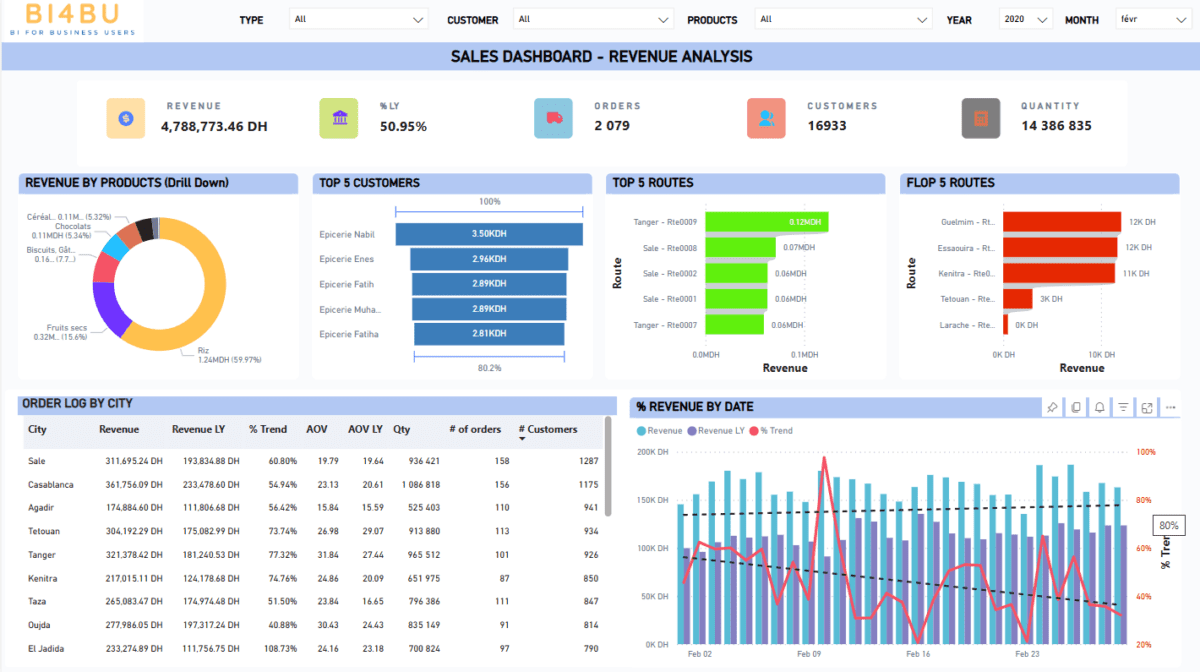Introduction to Business Intelligence
Business Intelligence, often abbreviated as BI, encapsulates a broad array of technologies, applications, and practices aimed at the collection, integration, analysis, and presentation of business data. The essence of BI is to transform raw data into meaningful information, enabling organizations to make informed decisions.
In today’s data-driven environment, the importance of BI cannot be overstated; it serves as a vital tool that empowers business users across various levels to gain insights that are essential for strategic planning and operational efficiency.
At its core, the purpose of business intelligence is to simplify the complexity of data. Traditional decision-making processes relied heavily on intuition and anecdotal evidence, which could foster uncertainty and risk. However, by leveraging BI tools and techniques, business users can access real-time data, analyze historical trends, and forecast future outcomes, all of which contribute significantly to sound decision-making. This capability allows organizations to remain agile, responding quickly to market changes and customer needs.
At its core, the purpose of business intelligence is to simplify the complexity of data. Traditional decision-making processes relied heavily on intuition and anecdotal evidence, which could foster uncertainty and risk. However, by leveraging BI tools and techniques, business users can access real-time data, analyze historical trends, and forecast future outcomes, all of which contribute significantly to sound decision-making. This capability allows organizations to remain agile, responding quickly to market changes and customer needs.

Moreover, BI equips everyday users—such as managers and analysts—with the ability to uncover trends, patterns, and anomalies within data sets, fostering a culture of data-driven decision-making. The empowerment granted by business intelligence means that individuals, regardless of their technical background, can engage with data and generate actionable insights. Thus, BI is not just a technical resource for IT departments; it is a strategic asset for the entire organization, promoting collaboration and driving business success. By breaking down silos and enabling cross-departmental data sharing, BI enhances overall organizational performance, making it an indispensable component in the toolkit of modern enterprises.
The Importance of Data in Business
In the contemporary landscape of business, data plays a crucial role in guiding decision-making and strategic planning. Organizations generate vast amounts of data daily, encompassing aspects such as sales figures, customer transactions, and market trends. This influx of information can be harnessed to provide actionable insights that significantly enhance business operations and outcomes.
Data collection methods vary widely, ranging from customer surveys and social media analytics to sales tracking and website usage metrics. By systematically gathering this data, businesses can create a rich repository that reflects their internal workings as well as external market conditions. Once collected, the subsequent step involves storing this data securely to ensure its integrity and accessibility. Storage solutions may include cloud services or on-premises databases, each chosen according to the organization’s specific needs and security protocols

However, the real value of data emerges during the analysis phase. Employing various analytical tools and techniques, businesses can interpret datasets to uncover patterns and trends that inform strategic decisions. For instance, analyzing customer purchasing behavior can reveal preferences and inform targeted marketing strategies, ultimately boosting sales and customer satisfaction. Furthermore, understanding market trends through data analysis can enhance competitive positioning by allowing businesses to anticipate changes and respond proactively.
Data-driven decisions not only support strategic goals but also foster a culture of informed actions among teams. With proper collection, storage, and analysis in place, organizations can operate more efficiently while adapting to ever-evolving market landscapes and customer expectations. As data becomes increasingly integral to all facets of business, organizations that prioritize a robust understanding of their data assets will invariably gain a competitive edge.
How Business Intelligence Helps Make Decisions
By harnessing the power of BI, users can sift through extensive volumes of data to uncover valuable insights that would otherwise remain obscure. Data visualizations, reports, and dashboards play a pivotal role in this process, allowing business users to comprehend complex data sets in a more accessible manner.
Data visualizations, such as charts, graphs, and maps, convert raw data into visual formats, enabling users to identify trends and patterns quickly. These intuitive representations help demystify data interpretation, making it easier for decision-makers to grasp key metrics without needing extensive analytical skills. For instance, sales trends over a specific period can be represented through a line graph, revealing peaks and troughs in performance, which can guide strategies effectively.
Data visualizations, such as charts, graphs, and maps, convert raw data into visual formats, enabling users to identify trends and patterns quickly. These intuitive representations help demystify data interpretation, making it easier for decision-makers to grasp key metrics without needing extensive analytical skills. For instance, sales trends over a specific period can be represented through a line graph, revealing peaks and troughs in performance, which can guide strategies effectively.
Furthermore, customized reports generated by BI tools provide a tailored overview of critical business data. These reports summarize essential KPIs (Key Performance Indicators) and other relevant metrics, making it easy for stakeholders to stay updated. Business users can leverage these insights to make timely decisions, such as adjusting inventory levels or reallocating resources based on performance evaluations.
Dashboards, which integrate various visualizations and reports into a single interface, enhance the decision-making process by providing real-time data access. With a holistic view of the organization’s performance at their fingertips, users can respond promptly to market changes or unforeseen challenges. The ease of navigating through these dashboards significantly reduces the time taken to analyze data, leading to faster and more accurate decision-making.
Overall, the substantial benefits of Business Intelligence tools enable everyday users to transform data into actionable insights, facilitating strategic decisions based on factual evidence rather than intuition alone.
Real-World Examples of Business Intelligence Usage
Business intelligence (BI) has transformed the way organizations operate, enhancing decision-making through data-driven insights. Numerous companies across various sectors exemplify this transformation through their innovative applications of BI tools. For instance, a prominent retail chain utilized BI analytics to track customer purchasing behaviors. By analyzing this data, they identified trends that led to more personalized marketing strategies, significantly increasing customer engagement and sales. This case illustrates how leveraging BI can directly influence customer satisfaction and profitability.
You can navigate through the Sales Revenues Dashboard developed using Power BI, to give a good idea how BI can transform raw data into meaningful visuals :
Another compelling example comes from a leading airline that adopted BI solutions to optimize its flight schedules and resource allocation. By analyzing historical data regarding flight delays, weather patterns, and passenger volumes, the airline was able to refine its operational processes. As a result, they reduced unnecessary delays and improved on-time performance, leading to a notable enhancement in overall customer experience. The use of business intelligence in this scenario underlines its crucial role in streamlining operations and meeting customer expectations.
Furthermore, a healthcare provider successfully implemented BI to manage patient care better. By analyzing data from electronic health records, the organization streamlined patient workflow, reduced waiting times, and ultimately improved patient outcomes. The insights gained through BI not only enhanced service delivery but also facilitated proactive decision-making in patient management, showcasing the vast potential of business intelligence in the healthcare sector.
These examples demonstrate that the impact of business intelligence extends far beyond mere data analysis. They highlight how organizations can harness insights from BI to refine operations, enhance customer service, and drive profitability. As more companies embrace such technologies, the relevance of business intelligence continues to grow, solidifying its position as an indispensable tool in today\’s data-driven business landscape.
Challenges That Business Users Face with Business Intelligence
The adoption of Business Intelligence (BI) tools among everyday users often presents a number of challenges that can hinder their effective utilization. One of the primary obstacles is the prevalence of misconceptions surrounding BI technologies. Many users may view BI solely as a tool for data analysts, leading to the unfortunate belief that they lack the requisite skills to engage with these systems effectively. This perception not only limits the participation of business users but also restricts the comprehensive use of BI that can drive decision-making across various organizational levels.
Moreover, there exists a resistance to utilizing data that can obstruct the seamless integration of BI into daily operations. Business users often prefer relying on intuition and experience over data-backed decisions, a tendency that can be attributed to a lack of understanding of the potential benefits that data-driven insights offer. This resistance can perpetuate a cycle where valuable data remains underutilized, ultimately affecting the organization’s overall performance and competitiveness. Encouraging a culture that values data literacy can help mitigate this issue, fostering environments where BI tools are embraced rather than shunned.
Another significant hurdle facing business users is the challenge of interpreting data. Even when users are equipped with BI tools, they may struggle to make sense of complex datasets, leading to difficulties in deriving actionable insights. To address this, organizations should prioritize comprehensive training programs that enhance users’ analytical skills and understanding of data storytelling. By providing context and cultivating an intuitive grasp of data patterns, business users can gain the confidence required to engage fully with the insights produced by BI tools.
In conclusion, overcoming the challenges associated with BI requires addressing misconceptions, promoting data usage, and improving data interpretation skills among business users. By prioritizing these aspects, organizations can enhance their BI adoption strategies, fostering a more data-driven culture that benefits all stakeholders.
Best Practices for Using Business Intelligence Effectively
To harness the full potential of business intelligence (BI), users must adopt best practices that enhance decision-making and operational efficiency. One of the first strategies involves setting specific, measurable goals. By identifying clear objectives, users can align their BI tools with desired outcomes, ensuring that their efforts are focused on actionable insights that drive success. This approach allows for better tracking of progress and effectiveness, leading to more informed decisions.
Another crucial aspect is ensuring data accuracy. The effectiveness of BI heavily relies on the quality of the data being analyzed. Users should engage in regular audits and validations of their data sources to prevent inaccuracies from skewing insights. This includes implementing strict data governance policies, such as controlled access and standardized data entry processes, which help maintain a high level of data integrity. Utilizing reliable data sources will not only improve the quality of insights derived from BI tools but also bolster the overall credibility of the decision-making process.
Continuous learning is also paramount in maximizing BI effectiveness. As the landscape of business intelligence evolves, users should take the initiative to stay updated on the latest trends, tools, and technologies. Participating in relevant workshops, attending webinars, or engaging in online courses can significantly enhance a user\’s understanding and usability of BI solutions. Furthermore, fostering a culture of curiosity and learning within teams can stimulate innovative approaches to data analysis and encourage collaboration, ultimately leading to better outcomes.
In implementing these best practices—setting specific goals, ensuring data accuracy, and committing to continuous learning—users can significantly enhance the benefits derived from their business intelligence initiatives. With a strategic approach, organizations can achieve more effective outcomes and make data-driven decisions that drive overall success.
The Future of Business Intelligence for Business Users
As organizations seek to enhance their decision-making processes, the future of business intelligence (BI) is poised for significant transformation. Emerging technologies, such as artificial intelligence (AI) and machine learning (ML), are beginning to redefine the landscape of BI, making it increasingly accessible to everyday business users. The integration of these advanced technologies is anticipated to change how data is analyzed, interpreted, and utilized across various sectors.
One of the primary trends shaping the future of BI is the development of automated analytics. By leveraging AI and ML algorithms, BI tools can process vast amounts of data and generate insights without the need for extensive human intervention. This capability not only streamlines the analysis process but also minimizes the risk of human error. As a result, business users will be able to obtain actionable insights more quickly and accurately, empowering them to make informed decisions with confidence.
Moreover, the concept of self-service BI solutions is gaining traction as organizations strive to democratize data access within their teams. With user-friendly interfaces and intuitive visualizations, business users can interact with their data directly, reducing dependency on IT departments. This shift allows non-technical users to explore data, create reports, and derive insights independently, further enhancing organizational agility.
Another significant trend is the incorporation of real-time data analytics into BI platforms. As businesses increasingly require timely insights to respond to dynamic market conditions, the ability to analyze data in real-time becomes crucial. BI tools that harness streaming data capabilities will enable business users to react promptly to changes, enhancing their overall competitiveness.
In conclusion, the future of business intelligence for business users looks promising, driven by advancements in AI, machine learning, and self-service analytics. These innovations will empower users to leverage data more effectively, ultimately leading to improved decision-making and business outcomes.
Conclusion: Embracing Business Intelligence
In this exploration of Business Intelligence (BI), we have identified its significance in the contemporary business landscape, particularly for everyday users. The role of BI tools in transforming raw data into actionable insights can no longer be understated. Businesses today are inundated with a plethora of data generated from various sources, and effectively leveraging this data is crucial for making informed decisions and fostering growth.
Undoubtedly, the integration of BI tools into everyday business practices empowers users to uncover trends, forecast future outcomes, and enhance operational efficiency. By harnessing the capabilities of BI solutions, business users can analyze patterns and derive insights that were previously obscured by the sheer volume of data. This provides a substantial competitive edge, allowing organizations to respond swiftly to market changes and customer preferences.
Moreover, for users to fully capitalize on the potential of Business Intelligence, it is essential to understand that BI is not solely the responsibility of data analysts or IT departments. Instead, BI tools are designed to be user-friendly and accessible for individuals at all levels within an organization. Thus, embracing BI means democratizing data access and fostering a culture of data-driven decision-making throughout the enterprise.
In essence, as we navigate an increasingly complex business environment, the urgency to embrace Business Intelligence solutions cannot be ignored. By making informed choices based on data, organizations can enhance their strategic planning and operational execution. To remain competitive, it is imperative that everyday users not only recognize the importance of BI but also actively integrate it into their workflows. The future of business lies in our ability to utilize data effectively, making Business Intelligence an indispensable asset for success.

